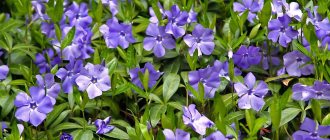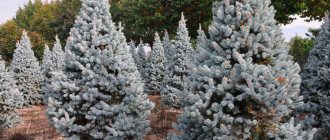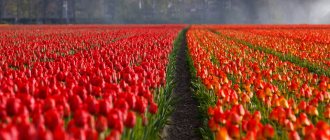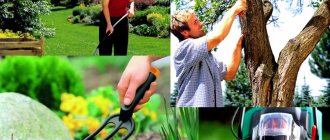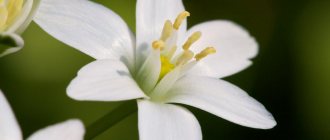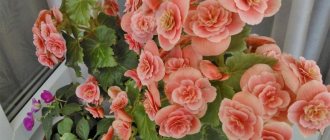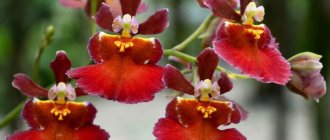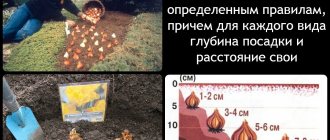Begonia belongs to the most famous and numerous genus of the family of the same name. This genus unites approximately 1 thousand species of various plants, which in natural conditions can be found in the mountains, and they prefer to grow at an altitude of 3-4 thousand meters above sea level; they are also common in tropical rainforests and subtropics. In this article we will look at the types of indoor begonia and photos with names.
Among begonias there are annual and perennial herbs, shrubs (occasionally climbing) or subshrubs with a creeping or tuberous-thickened rhizome, sometimes with a tuber. The leaves are usually asymmetrical, often beautifully colored (especially in cultivated species). The flowers are irregular, mostly unisexual, monoecious. Tepals are unequal, brightly colored; fruit - capsule.
A well-developed root system of begonia can be branched, fibrous or tuberous. Begonia, which has a root in the form of tubers, can be grown not only indoors, but also in the garden. Other types of begonia are grown only at home.
The Antilles are considered the homeland of begonia. The plant was discovered there at the end of the 16th century by participants in one of the scientific expeditions organized by Michel Begon. Subsequently, unknown at that time plants were named after him, found and described by the botanist from France Charles Plumier, who also participated in this trip.
Today there are a lot of hybrid forms of begonia in modern floristry. Depending on their decorative qualities, there are decorative deciduous and decorative flowering varieties. There is another classification, according to which varieties of incredible flowers are divided into three categories:
- leafy (propagation by roots);
- bush (propagated by seeds and apical shoots);
- tuberous (planted with tubers).
Decorative flowering begonias
This group includes large-flowered varieties of flowers from the Begoniaceae family. The leaves of these plants are narrow, small, and elongated. Their lower part is pubescent. The flowers are large (up to 30 cm in diameter), bright, double or simple. The buds can grow individually or be collected in clusters.
Representatives of this group bloom from summer to autumn (with proper care - from spring). In winter, plants shed their leaves and enter a dormant phase. Varieties of begonia that are found in this group: Ampelous, Elatior, Ever-blooming, Slender, Tuberous, Gloire de Lorraine, Fuchsia.
Everblooming
Ever-blooming
The species got its name due to its ability to bloom throughout the year. According to the height of the bushes, ever-flowering plants are divided into 3 subgroups: low-growing (14–18 cm high), medium (19–28 cm) and high (29–40 cm). The root system is fibrous. The trunk is lint-free, fleshy. Leaf plates are asymmetrical, rounded, smooth. Their colors range from dark green to burgundy. The surface of the foliage is glossy and shiny.
The buds are small (up to 25 mm in diameter), double or simple. Outwardly, they look like inflorescences of roses, peonies, and carnations. The color of the flowers is red, orange, peach, scarlet, yellow or white. Ambergris is one of the most popular varieties of domestic ever-flowering begonia.
Ambergris
Ambergris
- Description : low-growing flower, bush height - up to 15 cm, leaf blades - brown. The inflorescences are pink, up to 3 cm in diameter. The stem is dense, bare.
- Care : regular watering - three times a week in summer, as the soil dries out in winter.
- Conditions : It is recommended to grow in a well-lit place with shade from direct sunlight.
Elatior
Elatior
At home, this type of indoor begonia is grown more often than others. The height of Elatior bushes is up to 40 cm, the trunk is thick. The foliage is located asymmetrically, its shape is heart-shaped, the edge is jagged. The leaf blades are dark green shiny on the front side, light green matte on the back.
A pattern of pronounced veins is visible on the lower part. Their leaves are up to 8 cm. Inflorescences are bright, red or pink, up to 5 cm in diameter. Reproduction method is by seeds, cuttings. Begonia varieties Elatior for growing at home - Balladin and Borias.
Balladin
Balladin
- Description : a hybrid variety obtained by crossing the tuberous and Socotrans varieties of the flower. The height of the bush is up to 30 cm, the shape is compact. The buds are pink, white or deep red, 3–5 cm in diameter. The surface of the petals is double, semi-double or smooth. The foliage is large, glossy, up to 8 cm long. The stem is fleshy, erect.
- Care : abundant watering once a week, spraying the aboveground part.
- Conditions : temperature – +17–18˚C, shading from direct sunlight.
Borias
Borias
- Description : low-growing hybrid, crown shape – compact, leaf plates – glossy, dark green. The flowers are double or smooth, pale pink with a white edge. Inflorescences are multi-tiered. The stem is dense and fleshy.
- Care : temperature – 17–18˚C, abundant watering 1 day/7 days.
- Conditions : good lighting with protection from direct sunlight during the hottest part of the day.
Ampelnaya
Ampelous
Plants of this group are distinguished by thin drooping stems, up to 40 and sometimes up to 80 cm long. Based on the size of the buds, ampelous begonias are divided into small-flowered (inflorescence diameter 3–5 cm) and large-flowered (inflorescence size 10–15 cm).
Flower color – pink, white, red or mixed. The foliage is curly, dark green. It is recommended to plant such flowers in hanging flowerpots. Varieties of hanging representatives of the Begoniaceae family are united in a series.
Illumination
Ampelnaya
- Description : shoots are thin, hanging, up to 30 cm long. Inflorescences are double, 5–7 cm in size, color depends on the variety of the representative of this series. Begonia White Illumination has white flowers, Apricot Illumination has cream or yellow flowers, Non-stop apricot Illumination has apricot flowers, Champagne Illumination has light yellow flowers. The leaves are heart-shaped, bright green with light veins.
- Care : watering 1–2 times/7 days. warm water under the root.
- Conditions : comfortable temperature – +16˚C, planting in nutritious, drained soil.
Diseases and pests
Aphids, red spider mites and nematodes can settle on indoor begonias. Mites and aphids suck the juice out of the plant, as a result of which it loses its decorative effect and its growth and development slows down. To combat aphids, Karbofos or Actellik is used, which requires 2 or 3 treatments with a break of 1–1.5 weeks. And to combat ticks they use a product such as Derris, Decis or other insectoacaricides. If infected with nematodes, the plant will have to be thrown out, since it is impossible to get rid of them. You can find out that begonia is infected with nematodes by discolored leaf blades and swellings on the root system.
Begonia is susceptible to diseases such as: gray rot, black root rot, botrytis, true or downy mildew. Fundazol, Quadris, Bordeaux mixture, Skor or another remedy with a similar effect will help cure the plant. This plant is also susceptible to infection with incurable viral or bacterial diseases, for example: bacterial wilt, cucumber mosaic, tomato spot. The infected copy must be destroyed.
Begonia dries
Sometimes it happens that the leaf plates begin to dry out. The reason for this is that the air in the room is too warm and dry, as well as excessively poor watering. In this case, the begonia should be watered and placed in a cool place, with the pot placed on an inverted tray (more on this is discussed above).
Begonia turns yellow
It happens that rings or yellow spots form on the surface of the leaf blades - this is a sign that the plant is infected with tomato spot or cucumber mosaic. Infected specimens should be destroyed. If the leaves turn yellow and droop, the reason for this is that the plant is too cold and the soil contains too much water. Wait until the substrate in the pot dries thoroughly, and then move the flower to a warm place.
How to care for begonia at home
Basic elements of caring for home begonias:
- watering;
- shading from direct sunlight;
- fertilizing;
- protection from drafts and temperature changes;
- transfer.
Lighting
Indoor begonias love consistency. To grow them, it is recommended to choose a place where the flower pot will stand all the time. The optimal light regime for plants is 12 hours, with soft lighting in the morning (from 8 to 11) and in the evening (from 18 to 20). In the midday heat of summer, flowers need shading (white cloth, thin paper, blinds). Direct sunlight burns the foliage of flowers.
From November to February, flowers need to be illuminated with fluorescent lamps. The ideal place for flowering crop species is the east, west, northwest or northeast side of the house. Deciduous species, especially those with white, silver, and red spots, prefer to “live” on southern windowsills.
Conditions for growing begonias at home
Temperature
Comfortable temperature conditions for most indoor begonias: +22...25˚C in summer and +15...18˚C in winter. Varieties of tropical origin (Spotted, Royal, Metallica, Ringed) prefer t +18...23˚C. Subtropical species (Yellow, Diadema) grow well at t +13...18˚C.
Watering
In summer, it is recommended to water the crop frequently and abundantly - once every 2-3 days, in winter - as the soil dries out (about 1 ruble/7 days). For the procedure, settled or cooled boiled water is used. If the air temperature is high and humidity is low, the soil is moistened daily. Watering is carried out at the root or by immersing the pot in a pan of water for 15–20 minutes. Tuberous varieties are at a dormant stage in winter; they do not need to be watered at this time.
Humidity
House begonias grow well at air humidity of 50–60%. You cannot spray plants with a spray bottle. Only the Elatior Balladin species is normal for this procedure. The deciduous part of the remaining begonias suffers from spraying. After water gets in, brown spots form on the leaf blades, the foliage falls off, and the above-ground part of the crop dies. Ways to maintain optimal moisture levels:
- humidifier;
- a tray with wet expanded clay, peat or moss in which to place a flower pot;
- containers of water placed next to the plants.
Top dressing
Decorative deciduous varieties can be fertilized with nitrogen-containing compounds during watering every 14 days from early spring to late summer. Fertilizing inhibits the formation of buds and promotes the growth of green mass. For these varieties, Agricola is suitable: the consumption rate is 1.5–2 g/1 l of water.
Flowering varieties of domestic begonias are fertilized with:
- At the beginning of the budding period, use liquid complex fertilizers. For example, Kemira Lux. Consumption of the drug – 0.5 tbsp. l. / 5 l of water. The frequency of fertilizing is once every 2 weeks during watering.
- During the formation of ovaries and during flowering - phosphorus-potassium fertilizers. For example, Bud. Consumption of the drug – 1 ml/1 l of warm water. The frequency of fertilizing is once every 2 weeks during watering.
Transfer
Tuberous varieties are replanted annually in early spring. Varieties with fibrous and branched roots - when the pot becomes small. How to replant home begonia:
- The next day after watering, remove the plant from the container and shake off the soil.
- Dip the roots for 10 minutes in a light pink solution of potassium permanganate.
- Rinse the root system with warm water.
- Use a sharp knife to trim damaged, diseased and rotten roots.
- Sprinkle the cut areas with crushed activated charcoal or charcoal.
- Fill a new, larger pot with a soil mixture of peat, sand, black soil and garden soil (ratio 1:1:1:2).
- Lower the plant, straighten the roots, add soil.
- Water the flower.
General information about the exotic beauty
Begonia grows on the ground in many different ways. Gardeners note the following:
- creeping grasses;
- in the form of small bushes;
- tall upright options.
The root system of the plant is well developed, which allows begonias to grow not only in residential premises, but also outdoors. The root is tuberous, branched or fibrous.
Begonia flowers are small bouquets consisting of inflorescences of different sizes. They are:
- red;
- pinkish;
- yellow;
- orange;
- snow-white;
- different shades of petal edging.
In each inflorescence, begonia has flowers of different sexes. Thanks to this, she is pollinated. After this, an unusual triangular chest with tiny seeds grows. The plant blooms all summer until late autumn. Homemade varieties are pleasing to the eye until the beginning of winter.
Begonia tuberous
Tuberous begonia
Tuberous varieties are grown at home and in open ground. Based on the size of the buds, they are divided into subspecies: large-flowered (7–20 cm), medium-flowered (up to 7 cm), small-flowered (4–7 cm) and ampelous (2–4 cm). In terms of structure, the inflorescences are simple and double, and in color - white, yellow, pink, red or mixed.
The shoots are fleshy, branching, 35–50 cm long. The leaves are asymmetrical, juicy, bright green. The root system is fleshy tubers with a large number of small roots. To grow plants of this group, hanging pots and pots with high legs are used. According to their growth form, tuberous begonias are divided into erect and ampelous (hanging).
Erect
The stems of plants of this species grow upward. The shoots are fleshy, dense, juicy. Their length is from 10 to 40 cm. Flowers with erect trunks can be grown both at home in containers and in flower beds
Picoti Harlequin
Picoti Harlequin begonia
- Description : bush height – 25 cm, flowers – double, yellow with red edging. Their diameter is up to 12 cm. The foliage is green, oblong, with jagged edges and veins. The stems are dense, juicy, erect.
- Care : t – no higher than +24˚C, watering – once every two days in summer, as the soil dries out in winter, moisturizing by spraying the air next to the plant.
- Conditions : need to be shaded from direct sunlight.
Ampelnaya
Ampelous
Shoots of ampelous plants are hanging, up to 40 and sometimes up to 80 cm long. Such flowers are used to decorate loggias and gazebos. It is recommended to plant them in hanging and tall pots with legs.
Chanson
Chanson
- Description : buds are double or semi-double, 6–8 cm in diameter. Their color is yellow, red, copper or white. The stems are thin, hanging, 30–45 cm long. The leaf blades are carved, heart-shaped, green.
- Care : regular watering – 1 day/2 days. in summer, as the soil dries out in winter.
- Conditions : protection from direct sunlight.
Description of the appearance of a houseplant
The outer surface of the leaf is glossy , and the back side has a reddish or burgundy tint. Begonia Fista grows as a lush but compact bush, so it looks very good in a small pot. Adult plants grow no more than 25 cm in height. The features of this type of plant are:
- catchy appearance;
- low maintenance requirements;
- possibility of good development under artificial light;
- small size.
Begonia Fista is valued for its rare appearance of leaves. It blooms in small pink inflorescences.
Landing
Fill the prepared flowerpot one third with expanded clay; to prevent fungal diseases, add a small layer of charcoal. Pour some of the prepared soil on top. After placing the begonia in the prepared pot, carefully add the missing soil and water the plant generously.
It is best to plant begonias in the spring - March - April. At this time, the day is already long enough and the level of lighting is sufficient for the harmonious development of the plant.
If you are preparing tuberous begonias for planting, you must first germinate them in a bright, damp place at a temperature of 16-18ºC.
The history of the flower
Begonia is a wonderful plant that can be planted not only in a pot, but also in a garden, park, flowerbed, or near the border. The Begoniaceae family, to which it belongs, is huge. Breeders counted 900 full-fledged and 2000 hybrid species. The flower was first described in 1690 by Michel Begon. The name came from his last name. The plant began to be used as an ornamental crop only 200 years ago.
The history of begonia leads to the Antilles, where it was described by the discoverer Begon. A few years later they found Brazilian begonia. Then a royal view was discovered on the island of Hindustan. And in South America, a tuberous subspecies was bred. All modern varieties originated from them. The flower began to be widely used for decorative purposes and gained incredible popularity. At first it was grown only in greenhouses, and then adapted to home conditions.
To date, a large number of hybrids and varieties of cultivated begonia have been bred. According to their decorative qualities, all types are divided into two groups:
- blooming;
- decorative deciduous.
Recently, the tuberous appearance has gained popularity. It has incredibly bright flowers.
In nature, begonias grow in the tropics and subtropics. They love shade, moisture, steep shores near the sea and dry slopes in the mountains.
Features of watering
To keep the plant in good condition, it must be properly watered. Begonia at home requires special attention. In summer, the plant with massive stems and leaves should not dry out.
In normal temperature ranges, begonias need to be watered every 2-3 days, but in hot weather, watering should be done every day. This is especially important during the flowering period.
The soil should be well moistened, but there should be no stagnation of water. In this regard, vessel drainage plays a significant role. It should be about a quarter of its height. The best element for drying adult begonias is expanded clay.
Drainage system
It is best to water the plant with rain or stabilized water. Before watering, you need to make sure that the soil in the pot is almost completely dry.
Water should not get on the leaves or flowers of plants. If this happens constantly, the leaves will begin to rot.
Some begonias can be sprayed to humidify the air. However, this should not be done for stems and leaves with a velvety texture and any plants during flowering.

